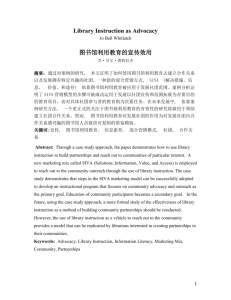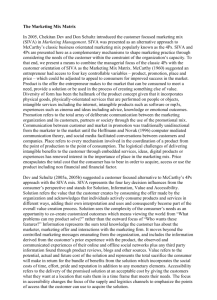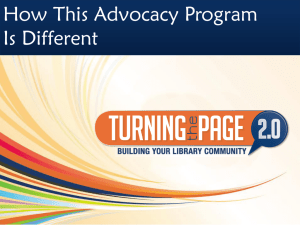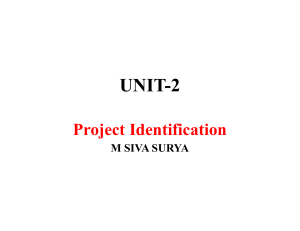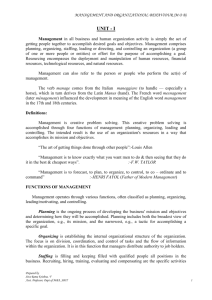Library Instruction as Advocacy - Evergreen Education Foundation
advertisement
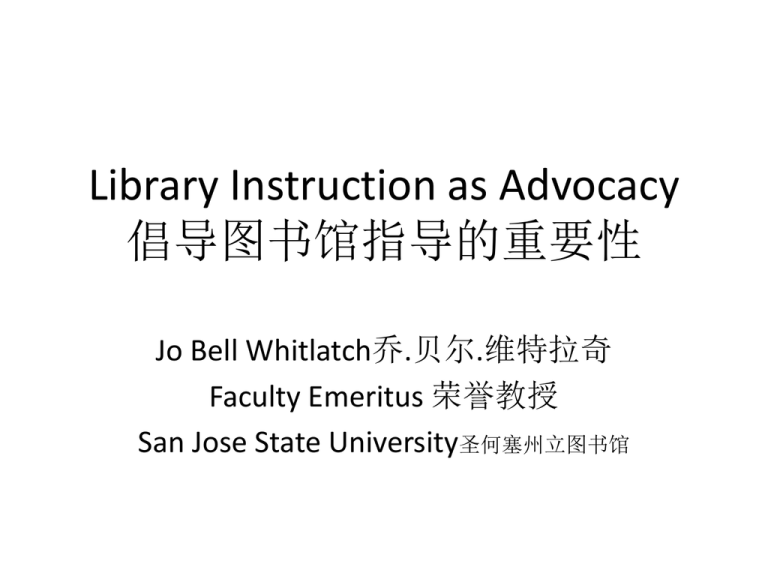
Library Instruction as Advocacy 倡导图书馆指导的重要性 Jo Bell Whitlatch乔.贝尔.维特拉奇 Faculty Emeritus 荣誉教授 San Jose State University圣何塞州立图书馆 Library Instruction图书馆指导 • Primary focus on building community partnerships and reaching out to communities of most interest 首要目标是建立社区合作关 系,拓展社区范围。 • Secondary focus on education, that is teaching of information literacy skills to students and citizens 培养学生和市民信息素养为次要目 标。 Why?为什么? • Students record only 20-40 percent of lecture’s main ideas in their notes 学生只能记 录讲座中20-40%的主要内容 • Without reviewing their notes, after three weeks, students remember less than 10 percent如果不复习笔记,3个星期之后,学生 只能记住不到10%的内容 Defining Advocacy 什么叫倡导图书馆指导 • Involves changing attitudes, policies, planning for change, improving understanding 包括改变态度,政策, 变化,以及提高理解力 • Promotes causes such as literacy, reading, information literacy, preservation of local culture 发展读写能力,阅读能力,信息素养, 当地文 化的保护 • Appeals to wants, needs, and values of community members • 关注社区成员的需求和价值 SIVA – Customer-Focused SIVA 以顾客为中心 • Solutions – How can I solve my problem? 解决方式-如何解决我的问题 • Information – Where can I learn more about it? 信息-我可以在哪里学到更多信息? • Value – What is my total sacrifice to get this solution? • 价值-为了获得解决办法我需要付出什么? • Access – Where can I find it? • 渠道-我在哪获得解决问题的办法? Six Important Lessons 6个重点 • 1. Library and local government leaders need to connect on community priorities 图书馆和当地政府领导人需要共同考虑社区 利益 • 2. Building partnerships is the key to innovation 建立伙伴关系是创新的关键 • 3. Leadership happens at all levels of the organization • 各个级别的组织出现领导力 Six Important Lessons (cont.) • 4. Successful partnerships require commitment to the effort 成功的伙伴关系需要坚定的努力 • 5. Innovation occurs in communities of all sizes • 各种规模的社区都可以有创新 • 6. Not every effort will be successful • 不是所有努力都会获得回报 Key Characteristics of the Community Centered Library 以社区为中心的图书馆的关键特征 • Priority is providing services to individuals, organizations, business, and institutions in the community 给社区的个人,组织,商业以及事 业单位提供优先服务。 • Recognizes library exists because of community and for community认识到图书馆 因社区存在,为社区存在。 • Library staff knows people come first – not things图书馆职员清楚摆在首位的是人,而 不是事。 Key Characteristics (Cont) 关键特征 • Actively solicits input from various community segments汲取各个社区的营养 • Facilitates partnerships between library and other agencies or between citizen groups and appropriate organizations • 促进图书馆和其他机构的合作,市民团体 件的合作 • Partnerships are beneficial to both the library and the partner organization • 合作有利于图书馆和其合作组织 Evaluating Potential Partnerships 评估潜在伙伴关系 • Partners must have common overlapping interests with libraries in solving information needs/problems of local citizens in certain domains • 在帮助当地市民某些信息问题方面,合作 伙伴与图书馆存在共同的利益 • Wilder Collaboration Factors inventory is very helpful in evaluating the potential and suitability of collaborative partners – see http://www.wilder.org/WilderResearch/Research-Services/Pages/WilderCollaboration-Factors-Inventory.aspx • 更广的合作因素有利于评估合作伙伴间的 潜能和和合适度。 University Case Study Applying SIVA Marketing Mix Steps 运用SIVA 营销组合步骤的大学案例分析 • San Jose State University • 圣何塞州立大学 • University Liaison system with academic teaching departments • 大学学院间的联盟 • Each librarian responsible for collaborating with teachers in assigned departments on library instruction, collection management, and research • 每位图书馆员负责在图书馆指导,信息收集管 理和研究方面与指定学院合作 SIVA Step 1 Understand Markets and Customer Value • • • • • • 步骤一:了解市场和消费者的价值 For each academic department, meet with all full-time teachers with open ended interview questions focused on their needs, wants and values. 通过采访,了解教师的需求和价值 Sample questions: 样本问题: What are their research interests and teaching specialties? 研究兴趣和教学特长是什么? How have they used libraries to meet their research needs? Their teaching needs? 如何利用图书馆满足他们的研究需求和教 学需求? • What did they like about library services? • 他们觉得喜欢图书馆服务? • What would they change about library services? • 他们对图书馆服务做出什么改变? • Did they assign papers or projects in their courses? If yes, which courses? 他们是否布置作业?如果有,什么样的课 有作业? • Did the students have adequate skills in locating, using, and evaluating information resources? [Here suggest library instruction, collaborative assignments if appropriate] • 学生是否具备寻找,使用和评估信息资源 的能力?(这里建议采取图书馆的指导和 SIVA Step 2 Create Customer Value Proposition 步骤2 创造消费者价值说 Depending on faculty wants, needs, and values, explore 基于教师的需求和价值, •developing library Web guides for core courses; •发展图书馆针对核心课程的网络指导 •offering library instructional sessions; •提供图书馆指导性会议 •designing collaborative assignments. •设计合作性作业 SIVA Step 3 Deliver Customer Value 步骤3 传递顾客价值 As needed, wanted, and valued by individual departmental faculty – 正如每个部门所需求和看重的那样: •Prepare library guides, •准备图书馆指导 •Offer instructional sessions, •举办指导性会议 •Develop collaborative assignments, and •Support individual student research •开展合作性作业,支持每个学生的研究工作 SIVA Step 4 Measure the Value Delivered 步骤四 评价所传递的价值 • Administer and analyze short student feedback surveys after each instructional session. • 会后分析学生反馈 • Faculty review of library Web guides. Encourage student suggestions for changes in library guides. • 教师复习图书馆网络指南。鼓励学生提出 更改性建议 • At end of class with collaborative assignments, discuss success and failures from teacher’s point of view. Administer and analyze student feedback survey on learning as result of assignment. Provide input on use of information sources in the paper and bibliography, including appropriate quality of sources and accuracy of citing sources. • 课后合作性作业方面,老师探讨成败,分 析学生完成作业后的学习情况,提供论文 和的文献的信息来源,包括来源的质量和 引用的准确性。 • Collect statistics on number of library sessions, use of Web guides. • 收集图书馆会议的次数和网络指导的统计 数据 • Maintain a log of assistance with specialized research questions and answering success. • 记录帮助解决研究问题的内容 Public Library Advocacy SIVA Step 1 Understand Markets and Customer Value 提倡公共图书馆的作用 SIVA 步骤一:理解市场和顾客价值 • Identify main target audiences and representative community groups – can be formal or informal organizations • 坚定主要受众和社区代表 • Offer instructional sessions to each of these groups • 开展指导性会议 • Conduct informal focus group sessions after instructional sessions to obtain feedback on customer wants, needs and values • 会后组织非正式的组织会议,搜集股客人需求和 价值 Public Library Advocacy SIVA Step 2 Create Customer Value Proposition 步骤二: 创造顾客价值说 • Review primary wants, needs, and values of community groups and identify organizational assets and resources that could be focused on meeting wants, needs and values. • 回顾社区组织的所需和价值,鉴定组织资产和资产。 • Evaluate the potential community partnerships and select the most promising ones [number selected may depend on combined organizational resources] • 评估有潜力的社区合作关系,选择最具潜力的合作 社区。 Public Library Advocacy SIVA Step 3 Deliver Customer Value 步骤3:传递顾客价值 Embed a librarian in each selected community organization 在每个社区组织安排一位图书馆员 In collaboration with each community organization, design and implement pilot projects for each community partnership. 与每个社区组织合作方面,设计和实施先导 性实验 Follow these steps for designing and implementing the pilot project: 具体步骤如下: •Identify the problem that needs attention •鉴定需关注的问题 •Define the various ways to solve the problem •鉴定解决问题的各种方式 •Select the process that appears to have the greatest chance of working •甄选最可靠地运作过程 •Set out the criteria against which to measure the success of the specific problem solving efforts •制定衡量解决具体问题的标准。 •Carry out the effort •具体操作 Public Library Advocacy SIVA Step 4 Measure the Value Delivered 步骤4:测量所传递的价值 • Evaluate what occurs • 评估所发生的情况 • Reflect upon whether the results have solved the problem to a satisfactory degree • 反思问题解决的满意程度 Conclusion总结 Library instruction as advocacy is a great way to gain community support and engagement with key information values, such as: 图书馆指导师获得社区支持以及重点信息价值,比如: •literacy, •信息素养 •reading, •阅读 •education, and •教育 •preservation of local arts and culture. •保护当地艺术和文化
